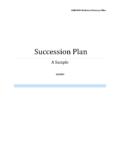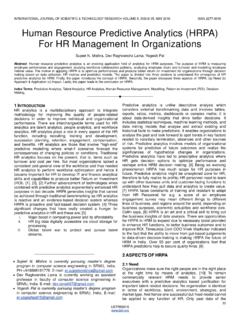Transcription of Sage HRMS I Planning Guide
1 sage hrms I Planning GuideWhat the CEO Needs From Human ResourcesHow to help executives make well-informed decisions about the HRMS2 Table of ContentsTop Business Challenges for Today s CEO ..3 What the C-Suite Worries About What the CEO Wants to Change About Workforce ManagementTo Deliver Strategic Value, Keep an Eye on the Bottom Line ..4 Key Metric: Labor Cost Revenue Percent Has HR Joined the Executive Team?Recruiting and Staffing ..5 What the CEO Needs: Staffing Reports Key Metric: Cost per HireTurnover and Succession Planning .
2 6 What the CEO Needs to Know: Plans for Top Performers Key Metric: Monthly turnover Compensation ..7 What the CEO Needs to Know: Competitor Compensation Plans Key Metric: Compa-RatioBenefits ..8 What the CEO Needs to Know: Benefits Cost Projections Key Metric: Average Benefits Cost per EmployeeSage HRMS3 Top Business Challenges for Today s CEOThe current economic environment has forced CEOs to focus almost all of their attention on revenues and profitability. They must be very aware of what competitors are doing and competitors can be anywhere in the world.
3 Additionally, executives are watching the government for indications of changing regulations and tax issues. What the CEO Wants to Change About Workforce ManagementIn many ways, the recent economic troubles served to shine a spotlight on workforce management issues for many executives. Whether it was navigating layoffs, reducing labor costs, cross-training employees, or simply keeping the workforce morale up, many leaders found that their organizations were not as nimble or flexible as they would like. 1 PriceWaterhouseCoopers, 13th Annual Global CEO Survey 2010.
4 2 Duke/CFO Business Outlook Survey, Global CFO Survey: CFO Optimism Tumbles, Employment Outlook Bleak, September 15, 2010. 3 PriceWaterhouseCoopers, 13th Annual Global CEO Survey Threats to Business Growth Citedby Chief Executive Officers (CEOs)1 65% Protracted global recession 60% Over-regulation 59% Lack of stability in capital markets 54% Low-cost competition 54% Energy costs 51% Availability of key skills 49% Protectionist tendencies of government 40% InflationWhat the C-Suite Worries About 65%60%59%54%51%49%1.
5 Federal Government agenda/policies2. Consumer demand3. Price pressure from competitors1. Maintaining profit margins2. Rising healthcare costs3. Low employee moraleTop Concerns of Chief Financial Officers (CFOs)2 ExternalInternalPercentage of CEOs Planning large or significant changes to areas of people management:3- 41% Better managing of people through change- 41% Morale and employee engagement- 40% Training and development- 25% Flexible working environments- 22% Collaboration with a network of outside specialists- 18% Compensation levels- 14% Pension and healthcare benefitsSage HRMS4To Deliver Strategic Value, Keep an Eye on the Bottom costs (compensation and benefits) account for nearly one-third of operating costs4, so how HR manages the workforce has a direct impact on achieving profitability objectives.
6 One of the best ways to set your HR strategy is to align workforce management goals with corporate objectives. That means keeping an eye on how your programs and decisions will impact the bottom line. Aligning labor costs with the quality of the workforce can dramatically improve financial performance. A 2009 study found leaders in talent management enjoyed superior financial results, including 54% higher net profit margins and 18% better HR Joined the Executive Team? To add strategic value, HR leaders should step outside the human resources arena and truly understand the business.
7 What does your company do? How much does it cost to deliver products? How does the competition do it? Who are your customers? Develop a workforce that supports the company s goals and customers. Help the executive team stay ahead of HR issues by finding answers before they ask questions. Are HR departments fulfilling this mission today? According to HR professionals, the answer is still no. KEY METRIC: Labor Cost Revenue Percent This metric describes labor costs in terms of the amount expended for each dollar of revenue the business generates.
8 It is basically the return on investment for your labor force. Divide total annual labor costs by revenue and express it as a percentage:On average, organizations spend about 22 cents in labor for every dollar of But the average for your specific industry is a better measurement of competitiveness. People-intensive industries such as professional services have a higher labor cost revenue percent. 4 Saratoga PwC, 2009/2010 US Human Capital Effectiveness Report. 5 Tony DiRomualdo, Stephen Joyce, and Nathalie Bression, Key Findings from Hackett s Performance Study on Talent Management Maturity, October 2009.
9 6 Human Resource Planning Society (HRPS) and Institute for Corporate Policy (i4cp), HR s Role in 7 Saratoga PwC, Metric of the month: Labor cost revenue percent, The Saratoga Review, October 2009 What role does senior HR leadership play in supporting and delivering organizational growth?6- 10% HR is not included in the growth 33% HR is on the sidelines, but contributes to spot roles such as 22% Senior HR leaders are consulted, but are below executive team 16% HR is the key to positioning the organization for 19% Senior HR leaders are part of the executive CostRevenue Percent x 100 (Compensation + benefits cost)Annual Revenue = sage HRMS5 Recruiting and StaffingStrategic executives avoid the nitty-gritty details of day-to-day human resources issues, preferring to take a broader perspective.
10 Executive priorities include recruiting and staffing, turnover and succession, compensation, and benefits. These are the most expensive functions of HR and the organizational challenges having the greatest impact on company objectives. Finding and hiring the right employees is essential to business success. The right hire can bring a team together and deliver brilliant new ideas. The wrong hire can be a disaster, resulting in lower team morale and missed objectives. A CEO needs his or her company to be seen as an employer of choice by potential candidates.









